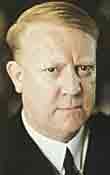Vidkun Quisling
(1887 - 1945)

Vidkun Abraham Lauritz Jonssøn Quisling was a Norwegian politician and officer commonly known as one of World War II’s most infamous traitors. He held the office of Minister President of Norway from February 1, 1942, to the end of World War II, while the elected social democratic cabinet of Johan Nygaardsvold was exiled in London. Quisling was tried for high treason and executed by firing squad after the war.
The term “quisling” has become synonymous with “traitor” in many European languages, including English.
Vidkun Quisling had a mixed and relatively successful background, having achieved the rank of major in the Norwegian army (some years before he had become the country’s best-ever war academy cadet upon graduation) and worked with Fridtjof Nansen in the Soviet Union during the famine in the 1920s, as well as having served as defense minister in the agrarian government 1931-1933. He was the son of the Lutheran minister and well-known genealogist Jon Lauritz Quisling, and both of his parents belonged to some of Telemark's oldest and most distinguished families.
On May 17, 1933, the Norwegian Constitution Day, Quisling and state attorney Johan Bernhard Hjort formed Nasjonal Samling (NS) (“National Unity”), the Norwegian national-socialist party. Nasjonal Samling had an anti-democratic, Führerprinzip-based political structure, and Quisling was to be the party’s Führer, much like Adolf Hitler was for the NSDAP in Germany. The party went on to have modest successes. In the election of 1933, four months after the party was formed, it garnered 27850 votes, following support from the Norwegian Farmer’s Aid Association, with which Quisling had connections from his time as a member of the Agrarian government. However, as the party line changed from a religiously rooted one to a more pro-German and anti-Semitic hardline policy from 1935 onwards, the support from the Church waned and, in the 1936 elections, the party got about.50,000 votes. The party became increasingly extremist, and party membership dwindled to an estimated 2,000 members after the German invasion.
When Germany invaded Norway on April 9, 1940, Quisling became the first person in history to announce a coup during a news broadcast, declaring an ad-hoc government during the confusion of the invasion, hoping that the Germans would support it. The background for this action was the flight northwards of the King and the government. Quisling had visited Adolf Hitler in Germany the year before, and was liked by Hitler, so Quisling’s belief that the Germans would back his government was not entirely unfounded. However, Quisling had little popular support, and the Quisling government lasted only five days, after which Josef Terboven was installed as Reichskommissar (Commissioner), the highest authority in Norway, reporting directly to Hitler. The relationship between Quisling and Terboven was tense, although Terboven, presumably seeing an advantage in having a Norwegian in a position of power to reduce resentment in the population, named Quisling to the post of “Minister President” (as opposed to Prime Minister) in 1942, a position the self-appointed “Führer” assumed in 1943, on February 1.
Vidkun Quisling stayed in power until he was arrested on May 9, 1945, in a mansion on Bygdøy in Oslo that he called Gimle after the place in Norse mythology where the survivors of Ragnarok were to live.
Quisling and two other Nasjonal Samling leaders, Albert Viljam Hagelin and Ragnar Skancke, were convicted and executed by firing squad. In later days, these sentences were controversial since capital punishment was reintroduced to the Norwegian legal system during the end of the war by the exile government to handle the postwar trials.
Maria Vasilijevna, Quisling’s Russian wife, lived in Oslo until she died in 1980. They had no children.
Source: Wikipedia.


